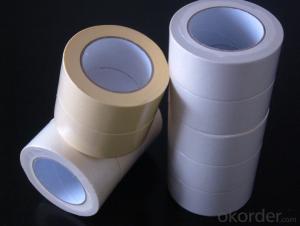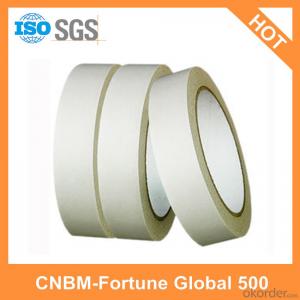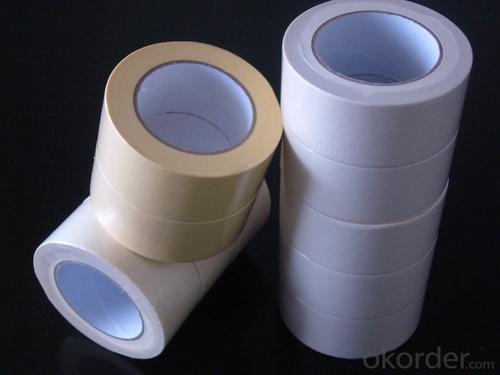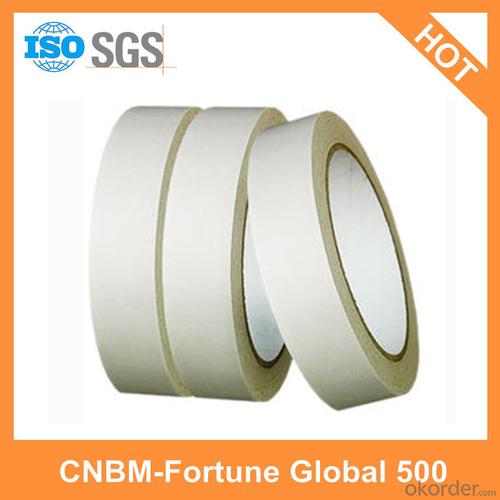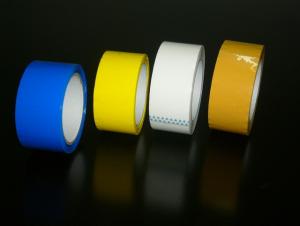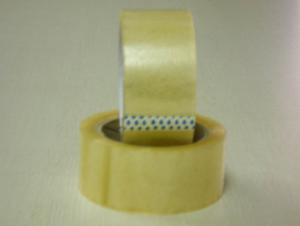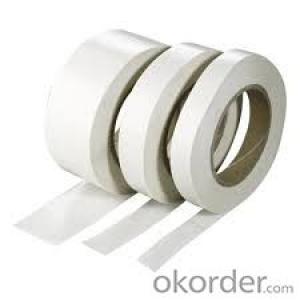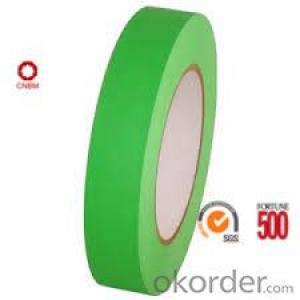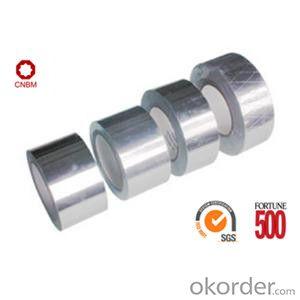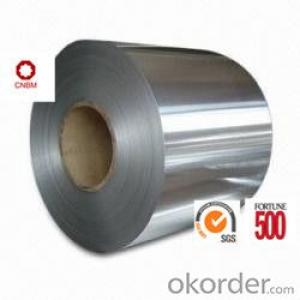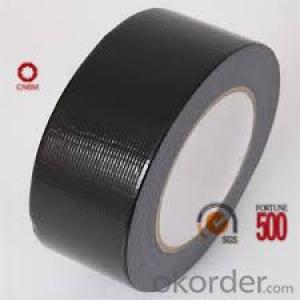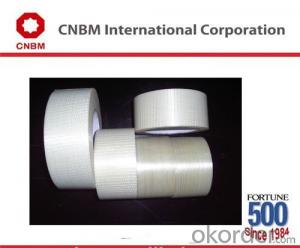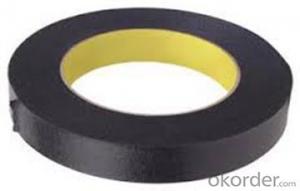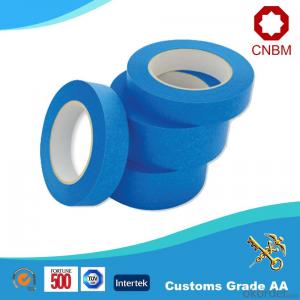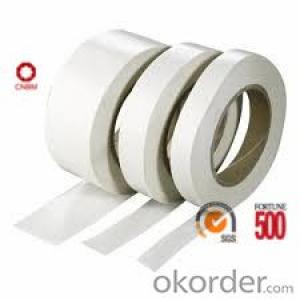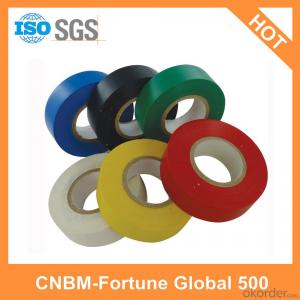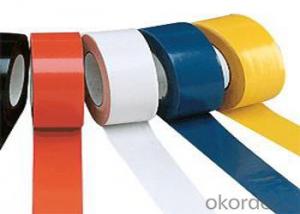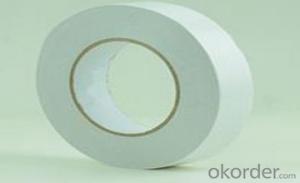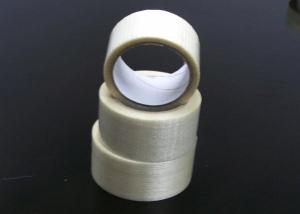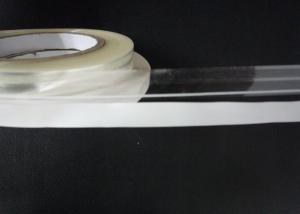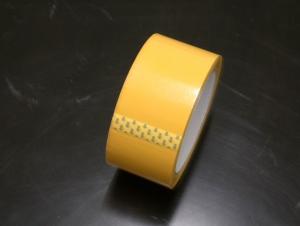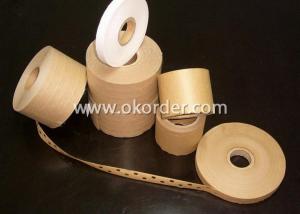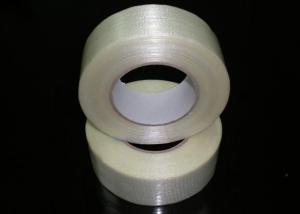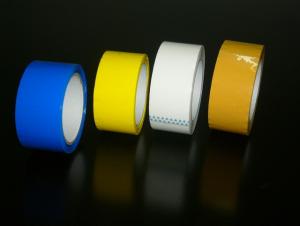CTI Packaging Tape - Double Sided Tissue Adhesive Tape Solvent Based Acrylic DSH-80H
- Loading Port:
- Tianjin
- Payment Terms:
- TT OR LC
- Min Order Qty:
- 10000 roll
- Supply Capability:
- 500000 roll/month
OKorder Service Pledge
OKorder Financial Service
You Might Also Like
1.Product Show
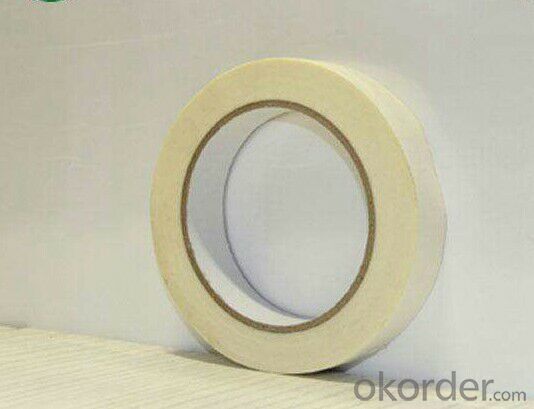
2.Company information
CNBM International Cooperation is a subsidiary company of CNBM Group, which is one of the biggest state-owned company and Fortune 500 companies in the world.
All of our products are very affordable as a result of being produced in special economic development regions of China and we are more than happy to help you with the import/exportprocess too!
3.Product Details
| Production name | Double Sided Tissue Tape water based acrylic DSW-80H |
| Material | Tissue + acrylic adhesive |
| Product Color | Transluscent |
| Usage | General use double adhesive |
| Advantage | 1.Factory supplier: We are a factory professional in making double sided tissue adhesive tapes 2.Competitive price:Factory direct sales, professional production, quality assurance 3.Perfect service:Delivery in time,and any question will be replied in 24 hours |
4.Our advangtages
1.BOPP tape, superb tack and adhesion to surface. Strong grip that is ensured because of an excellent adhesive backing.
Quality processing equipment that guarantees consistent quality.
2.Peak performance even under extereme conditions of pressure and temperature. Sticks on all types of surfaces.(paper, plastic, wood,glass,fiber,metal,etc)
3.Consistent quality; 4.On time delivery; 5.Effective and timely communication; 6.Competitive price.
5.Our Services
1.OEM Service
Your own design is appreciated; we can make the approval sample according to your golden sample.
2. QC Service
a) Before the order to be confirmed, we should check the material & color of fabric by sample which should be strictly.
b) We will be tracing the different phase of production from the beginning.
c) Every bad quality will be checked & cleaned before packing.
d) Before delivery clients could send one QC or point the third party to check the quality.
e) We will try our best to help clients when problem occurred.
3. After-sale Service
a) EXW, FOB, C&F are also available for us.
b) If the products need certificate, we can also provide.
6.FAQ
Q1: May I have samples?
A: Yes, Free samples available and freight collect by DHL,FEDEX,TNT,UPS,SF,ect.
Q2: Are you manufacturer or trading company?
A: We are professional Manufacturer/factory .
Q3: Can I use our own designing?
A: Yes, size, color, printing, logo, paper core, carton box can be customized.
- Q: What is the difference between acrylic and hot melt adhesive for packaging tape?
- Packaging tape commonly utilizes two types of adhesives: acrylic and hot melt. These adhesives possess distinct characteristics that set them apart. A significant disparity lies in their bonding strength. Hot melt adhesive boasts exceptional bonding strength, making it ideal for heavy-duty applications. It creates a robust and durable bond that can withstand rigorous handling and varying temperatures. Conversely, acrylic adhesive typically offers a lower level of bonding strength in comparison. While still suitable for most general packaging requirements, it may not be the best choice for heavy or bulky items. Another distinction can be found in the application process. Hot melt adhesive is applied in a molten state and solidifies once cooled. Typically, it is dispensed using a hot melt glue gun or applicator. The quick setting time of hot melt adhesive allows for swift packaging operations, making it popular in high-volume settings. On the other hand, acrylic adhesive is applied in a liquid form and requires some time to cure and establish a strong bond. It can be applied using a hand dispenser or tape gun, and optimal adhesion often necessitates some pressure. Moreover, hot melt adhesive demonstrates excellent adhesion to a wide array of surfaces, including cardboard, plastics, and metals. Its versatility allows for usage with various packaging materials. While acrylic adhesive also adheres well to different surfaces, it may not exhibit the same level of compatibility with certain low-energy surfaces, such as polyethylene or polypropylene. Furthermore, temperature resistance is an essential factor to consider. Hot melt adhesive performs admirably in both high and low temperatures, maintaining its bonding strength. It can endure freezing temperatures and heat without compromising its adhesive properties. Acrylic adhesive, while generally offering good temperature resistance, may not be as effective in extreme conditions, particularly at very high or low temperatures. In conclusion, the primary disparities between acrylic and hot melt adhesives for packaging tape lie in bonding strength, the application process, surface compatibility, and temperature resistance. While hot melt adhesive provides superior bonding strength, rapid setting time, and excellent temperature resistance, acrylic adhesive offers versatility, ease of application, and good adhesion to most surfaces. The choice between the two depends on specific packaging needs, materials used, and environmental conditions.
- Q: Does packaging tape come in different allergen-free options?
- Yes, packaging tape does come in different allergen-free options. Many manufacturers offer packaging tape that is specifically designed to be hypoallergenic and free from common allergens such as latex, gluten, and other potential irritants. These allergen-free options are particularly beneficial for individuals with sensitive skin or allergies. It is always recommended to carefully read the product labels or descriptions to ensure that the packaging tape meets your specific allergen-free requirements.
- Q: How do I remove packaging tape residue?
- There are a few simple methods you can try to remove packaging tape residue: 1. Rubbing alcohol can be used. Dampen a clean cloth or paper towel with rubbing alcohol and gently dab the residue. Allow it to sit for a few minutes before wiping away the residue. Repeat if needed. 2. Consider using Goo Gone or a similar adhesive remover. Apply a small amount of adhesive remover to a cloth or paper towel and gently rub the residue. Let it sit for a minute or two, then wipe away the residue using a clean cloth. 3. Warm soapy water is effective as well. Mix a few drops of dish soap with warm water. Dampen a cloth or sponge with the mixture and gently rub the residue. Rinse the area with clean water and thoroughly dry it. 4. Heat can be used for hard surfaces like glass or plastic. Use a hair dryer on a low setting and hold it a few inches away from the residue. Once the adhesive becomes soft, gently scrape it off using a plastic scraper or your fingernail. Remember to test any method on a small, inconspicuous area first to ensure it does not damage the surface.
- Q: Does packaging tape come in different dispenser options for ease of use?
- Packaging tape is available in different dispenser options, making it easier to use. The market offers various types of dispensers that are specifically designed to simplify the process of sealing boxes or packages. These dispensers come in different sizes, styles, and functionalities to accommodate different needs and preferences. One popular type of dispenser is the handheld dispenser. It is lightweight and compact, making it easy to handle and maneuver. These dispensers usually have a serrated blade for cutting the tape and a comfortable grip for better control. They are ideal for small to medium-sized packaging tasks. For larger packaging jobs, tabletop or benchtop dispensers are available. These dispensers are designed to sit on a surface and securely hold the tape roll in place, allowing for efficient and continuous taping. They often have a built-in cutting mechanism for easy and precise tape cutting. Moreover, there are automatic or electric dispensers that offer even more convenience. With these dispensers, you can effortlessly dispense and cut the tape with the push of a button, saving time and effort. They are especially useful for high-volume or repetitive packaging needs. To summarize, different dispenser options are available for packaging tape to cater to various preferences and requirements. Whether you need a handheld dispenser for small tasks or an automatic dispenser for larger volumes, there are dispenser options that can enhance the ease of use and efficiency of your packaging process.
- Q: Are there any specialty packaging tapes for specific applications?
- Indeed, there exists an array of specialty packaging tapes tailored for distinct applications. These tapes are specifically crafted to cater to the diverse needs and demands across various industries. Illustrative instances of specialty packaging tapes encompass: 1. Double-sided tapes: These tapes possess adhesive on both surfaces and are widely employed for mounting purposes, such as affixing posters or signs onto surfaces. 2. Tamper-evident tapes: These tapes produce a discernible mark or pattern upon removal, serving as evidence that the package has been tampered with. They are frequently utilized for securely sealing sensitive or valuable items during transportation. 3. Filament tapes: These tapes integrate fiberglass strands, imparting them with remarkable tensile strength. They are commonly employed for bundling weighty items or reinforcing packages that necessitate augmented sturdiness. 4. Masking tapes: These tapes offer a weak adhesive force and can be effortlessly detached without leaving residue or causing surface damage. They are frequently employed for masking off areas during painting or for temporary holding applications. 5. Printed tapes: These tapes can be customized with specific messages, logos, or branding in order to enhance the presentation of packages and foster brand recognition. 6. Cold temperature tapes: These tapes are engineered to endure exceedingly low temperatures and are frequently employed in cold storage facilities or for shipping goods that necessitate refrigeration. 7. Hazard warning tapes: These tapes boast vibrant hues and feature printed warning messages or symbols. They are often employed to mark hazardous areas or indicate potential dangers. These aforementioned examples merely scratch the surface of the extensive variety of specialty packaging tapes accessible in the market. Each tape is meticulously designed to meet distinct requirements, guaranteeing the secure and dependable packaging of diverse products or materials across various industries.
- Q: Is the insulating tape waterproof?
- There are special waterproof adhesive tape and insulating tape. It's not the same.General electrician work when two are used.Black wove feeling is insulated
- Q: How do I prevent packaging tape from becoming too loose?
- Here are some helpful suggestions for preventing packaging tape from becoming loose: 1. Opt for high-quality packaging tape: Invest in packaging tape that boasts a strong adhesive. Inferior quality tapes tend to lose their stickiness quickly, resulting in loose packaging. 2. Ensure cleanliness and dryness of surfaces: Prior to applying the tape, make sure that the surfaces are clean and dry. Dust, moisture, or oil can weaken the adhesive and cause the tape to loosen. 3. Apply firm pressure: When sealing a package, exert firm pressure while affixing the tape onto the surface. Be sure to run your hand or a flat object along the length of the tape to ensure proper adhesion. 4. Utilize overlapping tape: Instead of using only a single strip of tape, overlap it by a few inches. This overlapping technique provides added strength and diminishes the likelihood of the tape becoming loose. 5. Avoid extreme temperature fluctuations: Extreme temperature changes can adversely affect the adhesive properties of packaging tape. Refrain from storing packages in areas with high humidity or extreme temperature variations, as this can cause the tape to loosen. 6. Strengthen with extra tape: If you are sealing a heavy or bulky package, contemplate reinforcing it with additional tape. Apply extra strips of tape across the sides or diagonally to provide supplementary support and minimize the risk of the tape coming loose. 7. Properly store packages: When storing packages, ensure they are stacked correctly and not subjected to excessive pressure or weight. Inadequate storage conditions can cause the tape to loosen over time. By adhering to these recommendations, you can effectively prevent packaging tape from becoming too loose, thereby guaranteeing that your packages remain securely sealed during transit or storage.
- Q: What are the benefits of using low-noise packaging tape?
- There are several benefits of using low-noise packaging tape. Firstly, low-noise packaging tape is designed to minimize or eliminate the loud noise that traditional packaging tapes often make when they are being unwound or dispensed. This can be particularly beneficial in office or retail environments where there is a need for a quiet and peaceful atmosphere. By reducing the noise level, low-noise packaging tape helps to create a more comfortable and less disruptive work environment. Secondly, low-noise packaging tape is often made from high-quality materials that provide superior strength and adhesion. This means that it offers a reliable and secure seal on packages, reducing the risk of contents becoming damaged or lost during transit. The strong adhesive properties of low-noise packaging tape ensure that it stays in place even in challenging conditions, such as extreme temperatures or high humidity. Another benefit of low-noise packaging tape is its ease of use. It is typically designed to be easily dispensed from a tape dispenser, allowing for quick and efficient application. This saves time and effort for users, especially in high-volume packaging operations or busy shipping departments. The smooth and consistent unwinding of low-noise packaging tape further contributes to its ease of use, preventing tangles or snags that can lead to frustration and wasted tape. Additionally, low-noise packaging tape is often available in a variety of sizes, widths, and colors, allowing for customization according to specific packaging needs. This versatility ensures that it can be used for a wide range of applications, from sealing small envelopes or boxes to securing larger packages for shipping. The different color options can also help with organization and identification, making it easier to distinguish between different types of packages or to mark fragile items. In summary, the benefits of using low-noise packaging tape include reducing noise levels, providing reliable and secure seals, offering ease of use, and allowing for customization. By choosing low-noise packaging tape, businesses can improve the overall packaging experience for both employees and customers, leading to increased productivity, customer satisfaction, and the protection of valuable goods.
- Q: What are the common color options for packaging tape?
- The common color options for packaging tape include clear, brown, white, and various shades of blue, red, green, and yellow.
- Q: Can packaging tape be used for sealing food containers?
- Using packaging tape to seal food containers is not recommended. Although it may effectively secure boxes and packages, it is not suitable for use with food. It is important to seal food containers with materials specifically designed for food contact, such as food-grade plastic wrap, aluminum foil, or airtight reusable food storage containers. Applying packaging tape to food containers can introduce hazardous chemicals or adhesives that may contaminate the food, compromise its quality, or pose health risks. Therefore, it is crucial to prioritize food safety by using approved materials exclusively for sealing food containers.
Send your message to us
CTI Packaging Tape - Double Sided Tissue Adhesive Tape Solvent Based Acrylic DSH-80H
- Loading Port:
- Tianjin
- Payment Terms:
- TT OR LC
- Min Order Qty:
- 10000 roll
- Supply Capability:
- 500000 roll/month
OKorder Service Pledge
OKorder Financial Service
Similar products
Hot products
Hot Searches
Related keywords
